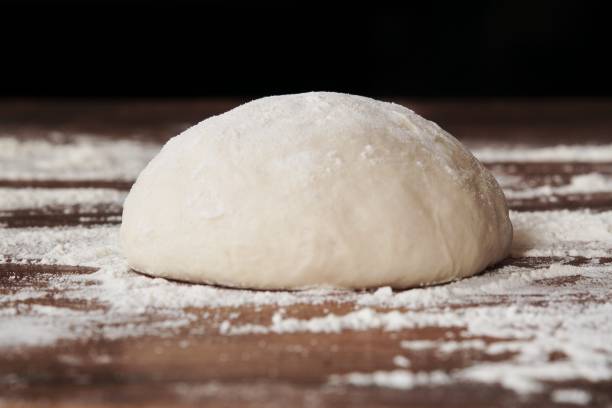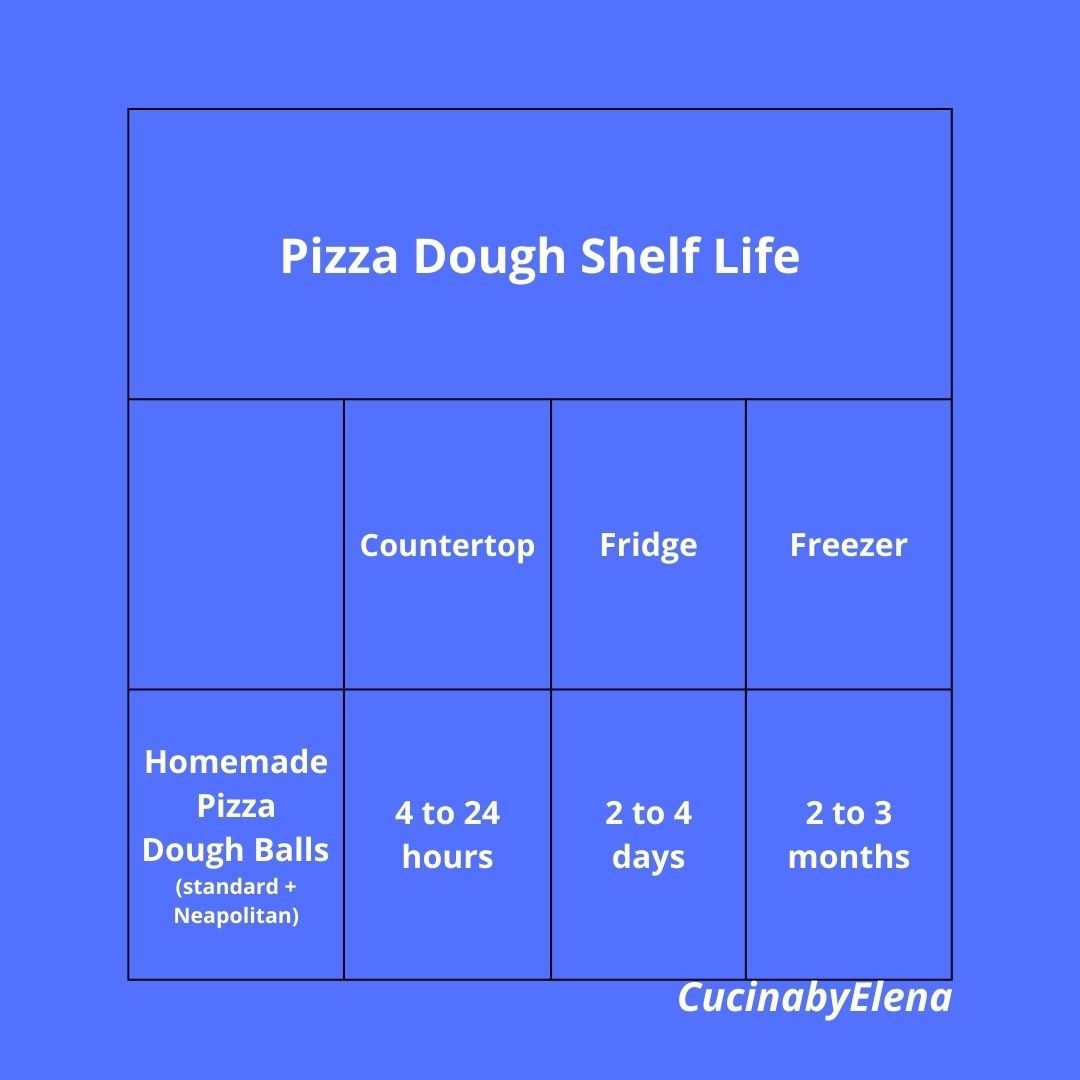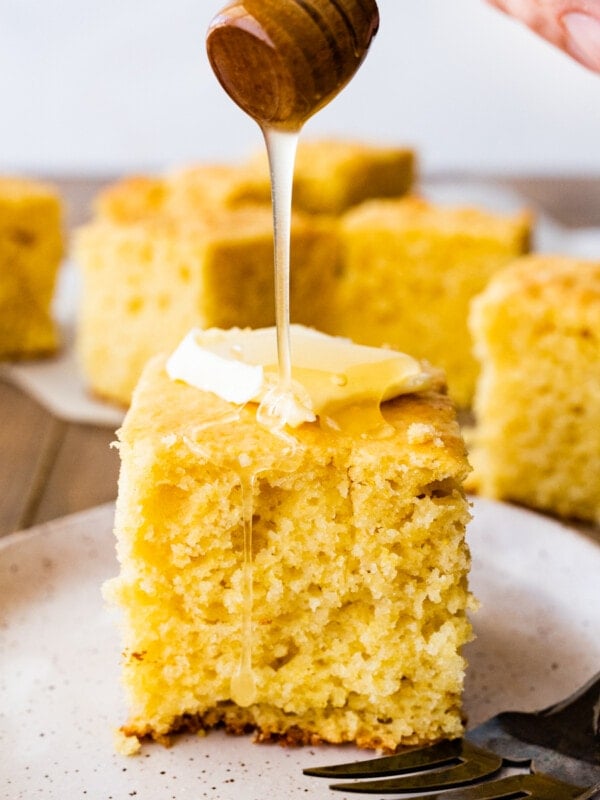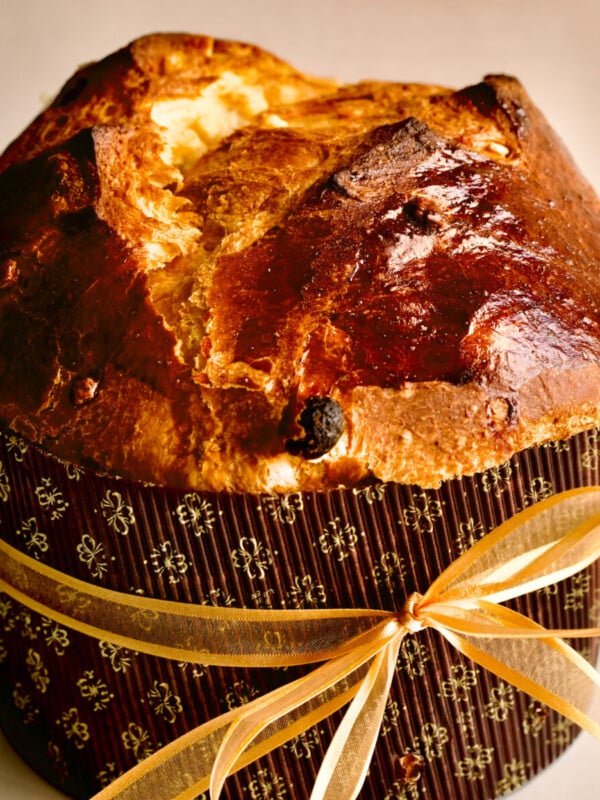How long Does Pizza Dough Last in the Fridge?
Jun 16, 2022, Updated Aug 24, 2023
This post may contain affiliate links. Please read our disclosure policy.
How long Does Pizza Dough Last in the Fridge? This is a question I get asked frequently since our Authentic Neapolitan Pizza Dough Recipe is a top reader and Google favorite! This post will answer that question and more! Find all the answers to your pizza dough storing questions HERE!

If you love to make pizza dough as much as we do- here is your guide to properly storing your dough. This post will walk you through how long you can store pizza dough on the counter, in the fridge and freezer, and how to properly thaw the dough for future use. Next time you are making pizza dough- store it properly and save extra for another time!
Storing your pizza dough the right way will change your homemade pizza life!
If you have leftover pizza dough, want to save time and work before the next pizza night, make a big batch of dough to store, or simply love the convenience of having pizza dough ready, you need to know how to store pizza dough properly.
Table of Contents
- Basic ingredients (Neapolitan pizza dough recipe)
- How long does pizza dough last?
- Pizza Dough Shelf Life Breakdown
- How to store pizza dough on the counter
- How to store during fermentation process (rest time)
- How long does pizza dough last in the fridge?
- How long does pizza dough last in the freezer?
- Why does pizza dough go bad?
- How to prevent pizza dough from going bad
- Making pizza dough 101
- What to serve with pizza
- FAQ’s for storing pizza dough
- Summary
Basic ingredients (Neapolitan pizza dough recipe)
Before we get into the storing process of pizza dough it is important to understand the simple ingredients that encompass homemade pizza dough- in this case our Authentic Neapolitan Pizza Dough Recipe.
- FLOUR For Neapolitan pizza, use type 0, or “00” flour. These are Italian-milled, finely ground flours that contain a high protein/gluten content of around 10-12%, which is perfect for a thin, crispy pizza crust. More on flour in the next section.
- WATER The water should around 20 degrees C (68 degrees F). When you knead the dough, the temperature will increase, that’s why the water doesn’t need to be too hot when you start the process.
- YEAST In Italy, t is most common to use natural fresh yeast or brewer’s yeast for pizza dough. You can find fresh yeast in almost all European grocery stores!
- I find natural fresh yeast very difficult to find in the United States, so I use a dried Italian yeast that I like.
- You can use active dry yeast that you find at most grocery stores as well. The amount of yeast used is minimal.
- The dough ferments slowly, over a longer period of time, so you don’t need much. I find it easier to digest when it is made this way.
- IMPORTANT TIP: When mixing the dough, the salt and yeast should not have too much direct contact. Why?
- If the yeast has too much contact with the salt it will damage the yeast cells. In turn, this will ruin the fermentation process. This is why the salt is mixed with water and flour before adding the yeast.
- SALT Neapolitan pizza is made with about 2.5- 3% fine sea salt.
- The purpose of the salt in Neapolitan pizza dough is to extend the fermentation time and to improve texture and flavor.
- Salt slows down the yeast. When adding salt to the dough, the yeast gets less active, and you get a longer, slower rise.
- Salt helps strengthening gluten so the dough keeps its shape during the long fermentation.
- A long and slow fermentation improves flavor and texture. The strong gluten formation makes the dough elastic and less prone to tearing.
- Can you believe the salt, also, helps brown and crisp the crust during baking? A lot information about SALT! Who new salt could play such an important roll in pizza dough
Special Note: Pizza doughs that include dairy products and/or olive oil may store differently than this simple yeast dough.
How long does pizza dough last?
How long pizza dough last depends the amount of yeast in the dough and the temperature the dough is stored (ex: fridge or counter). Yeast is more active in higher temperatures, so by lowering the temperature the yeast will slow in the proofing process.
Pizza dough stored at a lower temperature, like in the fridge (cold fermentation method), cool dry place, or freezer will last longer than at room temperature.
I recommend storing pizza dough when they are already divided into balls. Lear how to shape dough balls with a video in this recipe.
Pizza Dough Shelf Life Breakdown

How to store pizza dough on the counter
Standard pizza dough (with more yeast) can sit out on the counter for 2-4 hours, while a Neapolitan-style pizza dough (with less yeast) can be left out for up to 24 hours.
Letting the dough rise longer will give it a more complex flavor
Pizza dough should be stored in an airtight container, zip lock bags, or covered with plastic wrap. By doing that, the dough will not dry out and create a hard, dry surface.
To prevent sticking you dust the dough balls with flour.
How to store during fermentation process (rest time)
When making Neapolitan pizza dough you let the dough balls ferment from 24 hours. And if they are not stored properly, the surface will dry out.
The best way to store Neapolitan pizza dough balls is in a proofing box. A pizza proofing box is an air-tight container made for easy storing of pizza dough balls during proofing. Your dough won’t dry out when using one of these!
Proofing boxes come in all different sizes and can hold anywhere from 4 to 12 pizza dough balls. They make a great way to store your prepared dough balls.
These are the PROOFING BOXES I use and love.

How long does pizza dough last in the fridge?
For Neapolitan style pizza dough that rises at a slower rate (with less yeast) you can store dough in the fridge for up to 4 days.
For quick rise doughs that rise at a faster rate (with more yeast) you can store in the fridge for up to 2 days is recommended.
Cold fermented pizza dough
If you are using a cold fermentation process for your fresh dough, the easiest and most convenient way to store the pizza dough balls is in individual airtight containers. You can store the dough balls in a proofing box too, if you can fit it in your fridge.
Another option is coating them with a little flour and storing them in ziplock bags.
How to use refrigerated pizza dough
When you’re going to use the refrigerated dough, take it out of the fridge at least 1 hour before you’re planning to bake pizza, to let it come to room temperature. You can now use it just like any room temperature fermented pizza dough.
- Take the dough out from the fridge at least 1 hour prior to making the pizza.
- Let the dough come to room temperature.
- Stretch, shape, top with your favorite toppings and bake your pizza.
How long does pizza dough last in the freezer?
Pizza dough will last up to 3 months in the freezer to store for future use. When homemade pizza dough is stored in the freezer, the fermentation process stops completely and can store for an extended period of time.
Make sure the dough is wrapped in plastic wrap and stored in airtight containers to avoid freezer burns. You can also use ziplock bags.
For this reason- pizza dough keeps much longer in the freezer than in the fridge.
I prefer to freeze pizza dough after I divide them into equal portions and make them into balls. I find it is easier in the end since they are ready to go after the thawing process.
How to use frozen pizza dough
If you want to use frozen pizza dough to make pizza you have two options.
Fridge
- Place frozen dough in the fridge for 12-24 hours.
- When ready to use let the thawed dough come to room temperature on the kitchen counter for 1-2 hours before using.
Counter top
- Take the dough out from the freezer and leave it on the countertop for 4 hours.
- Let the dough thaw and come to room temperature.
- Stretch, shape, top with your favorite toppings and bake your pizza.
Why does pizza dough go bad?
There are a few distinct ways to tell if your pizza dough is bad.
SMELL
One of the most typical ways to determine that pizza dough went bad is to check its smell. A sour smell or an alcohol or beer odor as a result of the fermentation from the yeast.
In some cases, your pizza dough can smell like yeast. That doesn’t mean it is bad, and the smell is a result of pre-fermentation.
It is sort of like smelling rotten milk- your nose just knows when it is bad! Trust that.
COLOR
Fresh pizza dough has a cream or beige color. Grey color with flaky or orange peel on the surface of the dough means that it is not good anymore.
The color change appears after a while as a result of the enzyme-catalyzed phenolic and fatty acid oxidation. These compounds come from flour, so you should expect this happens after a while.
TEXTURE
If pizza dough loses elasticity and becomes dry, flaky, and crusty it is hard to roll into a ball or shape into a pizza base and not good anymore.
MOLD
Bad pizza dough can also have mold on it. Any mold occurrence is a warning sign that you need to discard the pizza dough. There may be harmful bacteria and it is not worth the risk!
How to prevent pizza dough from going bad
The last thing you want after going through the trouble of making your pizza dough is for it to turn bad!
The main culprits for pizza dough going bad are: time, temperature, and improper storage.
To avoid your pizza dough going bad make sure to follow the proper steps to store your dough properly (storage containers or proofing box) making sure it is stored at the right temperature, and not leave it out too long at room temperature or too many days in the fridge.
Making pizza dough 101
If you’ve never made your own pizza dough I have the perfect recipe to get you started!
- Authentic Neapolitan Pizza Dough Recipe
- You may also like: No Knead Italian Focaccia Bread and Fast Italian No Knead Ciabatta Bread
What to serve with pizza
All this talk on homemade pizza makes me hungry! If you are ready to make your own pizza and need serving suggestions- I have loads of ideas for you!

FAQ’s for storing pizza dough

Summary
Pizza dough will last for a few hours, days, or months, depending on the kind, procedure, storing temperature, and amount of yeast the recipe contains.
See “Pizza Dough Shelf Life” breakdown graph for a quick visual reference.
I hope you learned something new! Feel free to share this article with anyone who might enjoy it as well. Browse the website for more delicious and achievable Italian recipes!
Make sure to leave a ⭐️star rating on the recipe card and comment below if you make the recipe. I love to connect with you through my recipes.
I would love for you to tag me on Instagram @cucinabyelena so I can see your delicious Italian recipes. To get more ideas, follow me on Pinterest.








So informative – thank you for all the tips and tricks
You are most welcome! Enjoy the recipes and all the other tips and tricks! You might like this one: https://www.cucinabyelena.com/how-long-to-boil-spaghetti-pasta-perfect-every-time/